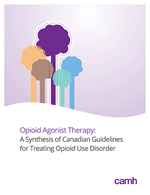Text adapted in 2023 from "Opioid Use and Opioid Use Disorders" in The Primary Care Addiction Toolkit. Available online only.
Unhealthy opioid use refers to a spectrum from at-risk or hazardous use to harmful use and addiction (Miller et al., 2018). Hazardous use and harmful use involve consuming an amount of opioids that is physically dangerous or using opioids in dangerous situations. At-risk or hazardous use increases the risk for health consequences, whereas harmful use means that the person has actually experienced health consequences of opioid use.
Unhealthy opioid use and chronic non-cancer pain
The prevalence of unhealthy opioid use among patients with chronic non-cancer pain varies, depending on the population and the care setting. Rates of at-risk opioid use range from 8 per cent to 30 per cent, and the prevalence of opioid use disorder ranges from 2.5 per cent to 14 per cent (Klimas et al., 2019; Voon et al., 2017). The 2019 Canadian Alcohol and Drugs Survey found that among people who used opioid pain relievers, 6 per cent had problematic use, a significant increase from 3 per cent in 2017 (Health Canada, 2020).
Aberrant drug-related behaviours
Behaviours that may indicate unhealthy opioid use are known as aberrant drug-related behaviours. They may suggest a loss of control over opioid use, which is a key indicator of addiction. Aberrant behaviours occur when opioids are used in ways other than intended by the prescriber. This includes:
- taking too much
- altering the route of delivery
- acquiring opioids from other sources (e.g., the street, double-doctoring).
Aberrant behaviours do not always indicate addiction. For example, patients with inadequately treated pain sometimes run out of medication early and request higher doses. This situation is known as pseudoaddiction and generally resolves with reasonable dose increases. In contrast, a patient with an addiction to opioids will continue to run out of medication early and seek higher doses, with no response to previous dose increases.
Aberrant drug-related behaviours may suggest opioid use disorder (Maumus et al., 2020). They include:
- Unauthorized dose escalation: Analgesic tolerance develops slowly. Patients with a stable pain condition are often able to remain on the same opioid dose for months or years (Ballantyne, 2006). In contrast, psychoactive tolerance develops within days or weeks, forcing a patient who is addicted to escalate the dose quickly to get the same effect. Patients with an opioid addiction often end up on doses well above what would normally be required to manage the pain condition (e.g., more than 200 mg morphine equivalent per day).
- Taking larger doses than prescribed, and frequently running out early: Patients with an opioid addiction tend to binge to achieve the desired psychoactive effect. Running out often triggers other behaviours, such as demanding fit-in appointments and experiencing anger and conflict.
- Chewing, smoking, injecting or snorting oral medications: This increases how fast the opioids enter the central nervous system, creating a more powerful euphoric effect.
- Acquiring opioids from other sources: Sources can include family and friends, the street, double-doctoring and the emergency department.
- Resisting medication changes despite adverse effects of opioid use
- Having concurrent problematic use of alcohol or illicit substances
- Showing inconsistent urine drug test results
- Cancelling clinic visits or failing to attend or follow up on them
- Saving unused medication for later use
- Altering, stealing or selling prescriptions and medication: Some patients seek prescription opioids in order to sell or distribute them to others.
Some aberrant behaviours may indicate inadequate management of pain rather than an opioid use disorder:
- Having an inconsistent history of analgesic response: Most patients report a modest, graded analgesic response. In contrast, patients with an addiction may say, “It’s the only thing that works” or “I can’t live without it” or “The dose is barely adequate and only takes the edge off.”
- Experiencing withdrawal symptoms at the end of a dosing interval (e.g., myalgias, dysphoria, anxiety, magnification of pain)
- Reporting immediately improved mood with opioid use, and possibly reduced drug craving.
Aberrant behaviours are commonly seen in primary care, so it is important to identify them, determine the underlying cause and create a plan for managing them. A higher number of aberrant behaviours is more likely to indicate an opioid use disorder or an untreated mental health disorder. There is no relationship between aberrant drug-related behaviours and the amount of opioid use or pain severity.


